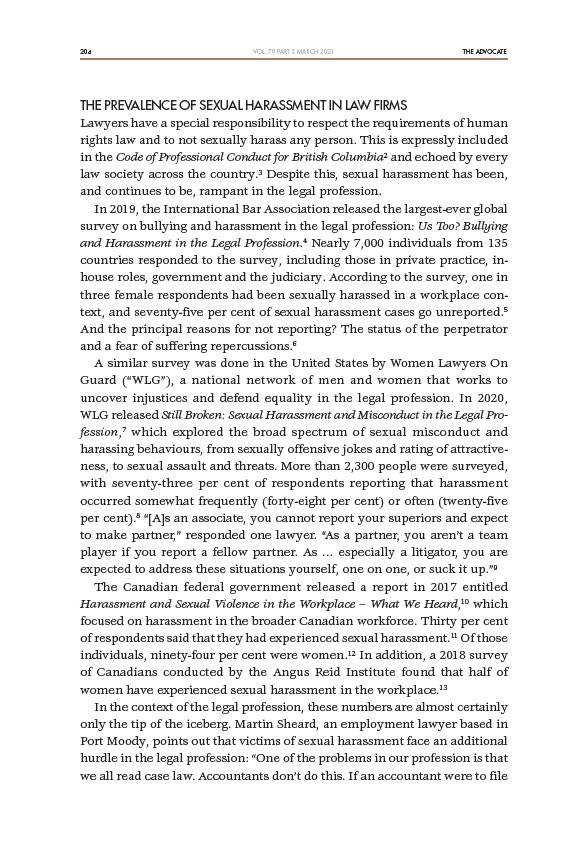
204 THE ADVOCATE
VOL. 79 PART 2 MARCH 2021
THE PREVALENCE OF SEXUAL HARASSMENT IN LAW FIRMS
Lawyers have a special responsibility to respect the requirements of human
rights law and to not sexually harass any person. This is expressly included
in the Code of Professional Conduct for British Columbia2 and echoed by every
law society across the country.3 Despite this, sexual harassment has been,
and continues to be, rampant in the legal profession.
In 2019, the International Bar Association released the largest-ever global
survey on bullying and harassment in the legal profession: Us Too? Bullying
and Harassment in the Legal Profession.4 Nearly 7,000 individuals from 135
countries responded to the survey, including those in private practice, inhouse
roles, government and the judiciary. According to the survey, one in
three female respondents had been sexually harassed in a workplace context,
and seventy-five per cent of sexual harassment cases go unreported.5
And the principal reasons for not reporting? The status of the perpetrator
and a fear of suffering repercussions.6
A similar survey was done in the United States by Women Lawyers On
Guard (“WLG”), a national network of men and women that works to
uncover injustices and defend equality in the legal profession. In 2020,
WLG released Still Broken: Sexual Harassment and Misconduct in the Legal Profession,
7 which explored the broad spectrum of sexual misconduct and
harassing behaviours, from sexually offensive jokes and rating of attractiveness,
to sexual assault and threats. More than 2,300 people were surveyed,
with seventy-three per cent of respondents reporting that harassment
occurred somewhat frequently (forty-eight per cent) or often (twenty-five
per cent).8 “As an associate, you cannot report your superiors and expect
to make partner,” responded one lawyer. “As a partner, you aren’t a team
player if you report a fellow partner. As … especially a litigator, you are
expected to address these situations yourself, one on one, or suck it up.”9
The Canadian federal government released a report in 2017 entitled
Harassment and Sexual Violence in the Workplace – What We Heard,10 which
focused on harassment in the broader Canadian workforce. Thirty per cent
of respondents said that they had experienced sexual harassment.11 Of those
individuals, ninety-four per cent were women.12 In addition, a 2018 survey
of Canadians conducted by the Angus Reid Institute found that half of
women have experienced sexual harassment in the workplace.13
In the context of the legal profession, these numbers are almost certainly
only the tip of the iceberg. Martin Sheard, an employment lawyer based in
Port Moody, points out that victims of sexual harassment face an additional
hurdle in the legal profession: “One of the problems in our profession is that
we all read case law. Accountants don’t do this. If an accountant were to file